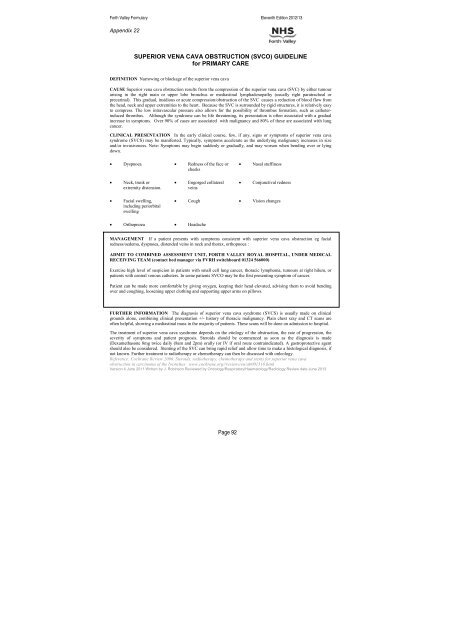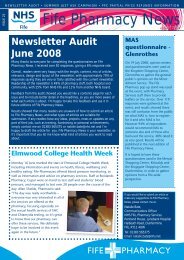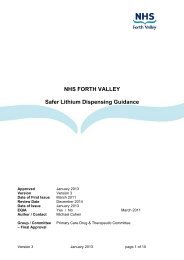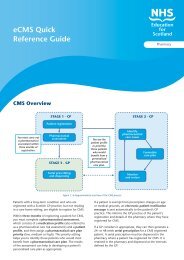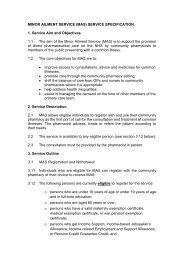nhs forth valley formulary 11 - Community Pharmacy
nhs forth valley formulary 11 - Community Pharmacy
nhs forth valley formulary 11 - Community Pharmacy
You also want an ePaper? Increase the reach of your titles
YUMPU automatically turns print PDFs into web optimized ePapers that Google loves.
Forth Valley Formulary Eleventh Edition 2012/13Appendix 22SUPERIOR VENA CAVA OBSTRUCTION (SVCO) GUIDELINEfor PRIMARY CAREDEFINITION Narrowing or blockage of the superior vena cavaCAUSE Superior vena cava obstruction results from the compression of the superior vena cava (SVC) by either tumourarising in the right main or upper lobe bronchus or mediastinal lymphadenopathy (usually right paratracheal orprecarinal). This gradual, insidious or acute compression/obstruction of the SVC causes a reduction of blood flow fromthe head, neck and upper extremities to the heart. Because the SVC is surrounded by rigid structures, it is relatively easyto compress. The low intravascular pressure also allows for the possibility of thrombus formation, such as catheterinducedthrombus. Although the syndrome can be life threatening, its presentation is often associated with a gradualincrease in symptoms. Over 90% of cases are associated with malignancy and 80% of these are associated with lungcancer.CLINICAL PRESENTATION In the early clinical course, few, if any, signs or symptoms of superior vena cavasyndrome (SVCS) may be manifested. Typically, symptoms accelerate as the underlying malignancy increases in sizeand/or invasiveness. Note: Symptoms may begin suddenly or gradually, and may worsen when bending over or lyingdown.• Dyspnoea • Redness of the face orcheeks• Nasal stuffiness• Neck, trunk orextremity distension.• Engorged collateralveins• Conjunctival redness• Facial swelling,including periorbitalswelling• Cough • Vision changes• Orthopnoea • HeadacheMANAGEMENT If a patient presents with symptoms consistent with superior vena cava obstruction eg facialredness/oedema, dyspnoea, distended veins in neck and thorax, orthopnoea :ADMIT TO COMBINED ASSESSMENT UNIT, FORTH VALLEY ROYAL HOSPITAL, UNDER MEDICALRECEIVING TEAM (contact bed manager via FVRH switchboard 01324 566000)Exercise high level of suspicion in patients with small cell lung cancer, thoracic lymphoma, tumours at right hilum, orpatients with central venous catheters. In some patients SVCO may be the first presenting symptom of cancer.Patient can be made more comfortable by giving oxygen, keeping their head elevated, advising them to avoid bendingover and coughing, loosening upper clothing and supporting upper arms on pillows.FURTHER INFORMATION The diagnosis of superior vena cava syndrome (SVCS) is usually made on clinicalgrounds alone, combining clinical presentation +/- history of thoracic malignancy. Plain chest xray and CT scans areoften helpful, showing a mediastinal mass in the majority of patients. These scans will be done on admission to hospital.The treatment of superior vena cava syndrome depends on the etiology of the obstruction, the rate of progression, theseverity of symptoms and patient prognosis. Steroids should be commenced as soon as the diagnosis is made(Dexamethasone 8mg twice daily (8am and 2pm) orally (or IV if oral route contraindicated). A gastroprotective agentshould also be considered. Stenting of the SVC can bring rapid relief and allow time to make a histological diagnosis, ifnot known. Further treatment ie radiotherapy or chemotherapy can then be discussed with onlcology.Reference: Cochrane Review 2006. Steroids, radiotherapy, chemotherapy and stents for superior vena cavaobstruction in carcinoma of the bronchus www.cochrane.org//reviews/en/ab001316.htmlVersion 4 June 20<strong>11</strong> Written by J. Robinson Reviewed by Oncology/Respiratory/Haematology/Radiology Review date June 2013Page 92


